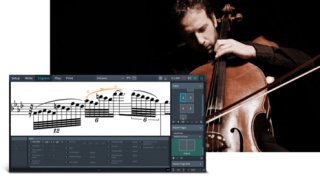 Steinberg has announced Dorico – a new app that’s described as a ‘next-generation professional scoring software for composers, arrangers, engravers, copyists and educators’.
Steinberg has announced Dorico – a new app that’s described as a ‘next-generation professional scoring software for composers, arrangers, engravers, copyists and educators’.
It’s named after Valerio Dorico, one of the most important music printers in 16th-century Rome.
Here’s what they have to say about it:
Dorico provides the most flexible note input and editing functionality of any scoring application, including the ability to work entirely in open meter or to freely rebar existing music, while maintaining clear and unambiguous rhythmic notation at all times.
Only Dorico allows composers to experiment freely with musical ideas, including seamlessly inserting music within an existing passage, or changing the durations of existing notes, and have correct notation produced automatically after every step.
The application also provides unique capabilities for project management, allowing users to easily produce works with an unlimited number of staves and movements, sections or pieces within the same project. Dorico facilitates the creation of various score layouts with independent page size, staff size and system layout, powered by a desktop publishing-quality page layout engine.
Dorico’s graphical output is intended to uphold the centuries-old craft of fine music engraving, with attention to even the smallest of details. Taking every subtlety into account, Dorico aims to fulfill the aesthetic demands of the most discerning engravers and publishers, providing extensive capabilities for graphical tweaking and editing.
Dorico’s multi-threaded architecture makes the software smooth and responsive, even when working on large-scale projects. Building on Steinberg’s audio engine, Dorico comes with a host of sumptuous VST instruments and effects, including HALion Sonic SE and the entire HALion Symphonic Orchestra library.
Features:
- 64-bit scoring software for OS X and Windows, designed by musicians for musicians
- Beautiful engraved output with unrivaled attention to detail
- Flexible note input and powerful editing, including ability to insert and change duration of existing notes
- Single-window interface puts every tool at your fingertips
- Powerful score management features to handle multiple independent pieces of music within the same project
- Unlimited number of staves and movements, sections, or pieces within the same project
- Create layouts for full scores and instrumental parts with independent page size, staff size and system layout
- Use your computer keyboard or MIDI keyboard to input music quickly and efficiently
- Optical kerning of adjacent elements, with tighter default spacing and no rhythmic distortion
- Import and export in MusicXML, MIDI and graphics formats
- Steinberg audio engine with flexible routing for virtual instrument and effect playback
- Compatible with VST 3 virtual instruments and effects processors
- Virtual instruments include more than 1,500 sounds, including HALion Sonic SE 2 workstation and complete HALion Symphonic Orchestra library
- Suite of high-end VST effect processors, including channel strip modules (compressor, EQ, limiter) and convolution reverb
Dorico will be available in the fourth quarter of 2016 for 579 Euro, or 349 Euro education pricing. A special crossgrade offer for qualifying Sibelius and Finale users will also be available for 299 EUR.

I’m glad to see some forward movement in notation. Thus far, programs have all seemed needlessly tedious.
I’m a little disappointed by the price. Not saying it isn’t worth it, just saying, I won’t be able to join this particular party.
Reaper 5.20 just added MIDI notation editor, but I haven’t tried it myself yet… https://youtu.be/QLppbRmFWYg
This looks interesting. One of the few bits of news lately that actually seems meaningful and promising. I’ll be following this with interest.
Compoze Leadsheets is the best notation app I’ve seen on iOS
https://compoze.app.link/SPtIqlZTLz